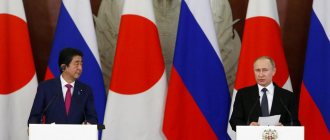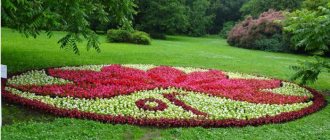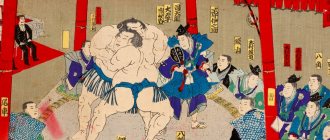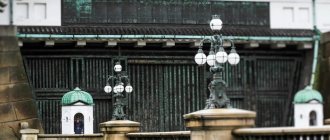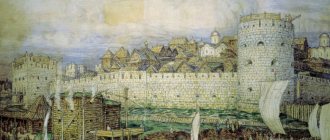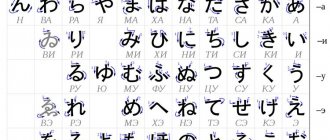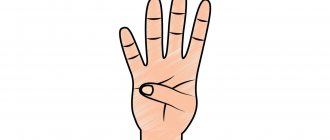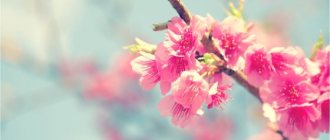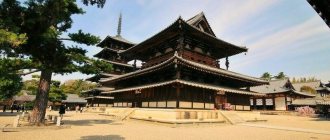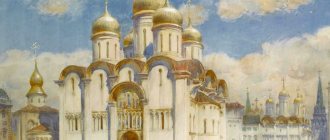Greetings, Friends. Igor Korotkov is with you. You are on the website Venasera.ru. Today we will talk about Japanese writing .
Traditionally, the Japanese language uses a vertical way of writing, i.e. The characters go from top to bottom and the columns go from right to left. This method continues to be widely used in fiction, as well as in newspapers. But in everyday life they usually use the standard, familiar to us, European way of writing , i.e. from left to right from top to bottom.
Writing in the Japanese language is divided into 2 Japanese syllabic alphabet Hiragana and Katakana , as well as kanji (hieroglyphs) .
ひらがな
Hiragana is used to write inflected parts of words, grammatical particles, or words whose hieroglyphic spelling has fallen out of use.
Hiragana characters are characterized by rounded, soft writing. Hiragana (平仮名) is translated from Japanese as “smooth alphabet” - that is, not “angular” like Katakana (片仮名). Hiragana was used by female authors of diaries and novels in the 9th to 12th centuries. Japanese poetry was written with it. Hiragana was a kind of “lightweight” letter, since it was believed that hieroglyphs for women were very difficult.
about how to easily and quickly remember the Hiragana alphabet in this video.
How to learn Japanese letters and alphabet
If you have a need to master the Japanese language or you simply love everything new and mysterious, then it’s time to learn at least Japanese letters, that is, hieroglyphs that are components of the Japanese alphabet. It's not that difficult to do this now. It is not at all necessary to go to a language school or look for a professional tutor. It is enough to use the material presented on the pages of our website. Here you will find the Japanese alphabet with translation into Russian, as well as various exercises for speech development and even step-by-step lessons on learning the Japanese language.
Have you ever dreamed of speaking Japanese? Then start learning the alphabet, after which you can move on to more complex aspects of the language.
カタカナ
Another alphabet is katakana , used to write borrowed words from foreign languages. Those. Your name will also be written using the Katakana , because... it's foreign. Also, sometimes katakana is used to write the names of animals, plants, and also as a stylistic device to highlight the desired word.
Literally, Katakana (片仮名) is translated from Japanese as “angular alphabet.” Katakana characters are angular and sharp, in contrast to hiragana characters, which differ significantly in their smoothness. Compare! This is Hiragana and this is Katakana.
We talked about how to easily and quickly remember the Katakana alphabet in this video.
Katakana was invented by monks to rewrite Chinese texts, in particular Buddhist sutras, and just like Hiragana, it originated from Chinese characters, but not from whole characters (as was the case in Hiragana ), but from their parts. Unlike hieroglyphs the Hiragana and Katakana syllabaries convey only sound, without any meaning.
In order not to waste your time, we will not dwell in more detail on the origin of Japanese writing , but will move on to examples.
Japanese characters. History and reading.
Good afternoon, dear craftsmen and buyers of the Fair! Towards the end of Japan Week, I would like to introduce you to the history of the origin of Japanese characters, the types of their reading and classification. Enjoy reading!
Japanese characters were borrowed by the Japanese in China in the 5th-6th centuries. AD To the borrowed characters were added hieroglyphs developed by the Japanese themselves (kokuji). In addition to hieroglyphs, two components of the alphabet are also used for writing in Japan: hiragana and katakana, Arabic numerals and the Latin Romaji alphabet.
Story
The Japanese term kanji translates to "signs of the (Han) Dynasty." Kanji is a hieroglyphic letter, an integral part of Japanese writing.
It is not known exactly how Chinese characters came to Japan, but today the generally accepted version is that the first Chinese texts were brought in at the beginning of the 5th century. These texts were written in Chinese, and in order for the Japanese to be able to read them using diacritics while observing the rules of Japanese grammar, the kanbun , which originally meant “classical Chinese composition.”
The Japanese language at that time did not have a written form. The Manyoshu writing system was created to record native Japanese words . The words in it were written in Chinese characters according to their sound, not their content.
Manyoshu, written in hieroglyphic cursive, evolved into hiragana , a writing system for women for whom higher education was almost inaccessible. Most of the literary works of the Heian era with female authorship were written in hiragana. katakana arose : students from monasteries simplified Manyōshū to a single meaningful element. These writing systems, katakana and hiragana, were derived from Chinese characters and subsequently developed into syllabic alphabets, which are collectively called Kana or Japanese syllabary.
Hieroglyphs in modern Japanese are mostly used to write the stems of words in nouns, adjectives and verbs. On the other hand, hiragana is used to write inflections and endings of verbs and adjectives, particles and words in which the characters are difficult to remember. Katakana is used to write onomatopoeia (onomatopoeia) and gairago (loan words).
Japanese innovation
At first, Chinese and Japanese characters were practically no different from each other: the latter were traditionally used to write Japanese text. However, nowadays there is a big difference between Chinese Hanzi and Japanese Kanji: some characters were created by the Japanese themselves, and some received different meanings. In addition, after the Second World War, many Japanese characters were simplified in writing.
Kokuji are characters of Japanese origin. Kokuji is sometimes called Wasei kanji ("Chinese characters created in Japan"). In total, there are several hundred kokuji. Most of them are rarely used, but some have become important additions to the written Japanese language.
In addition to kokuji, there are characters that have different meanings in Japanese than in Chinese. Such hieroglyphs are called kokkun - “signs of national reading”).
Old and new hieroglyphs
The same character can sometimes be written in different styles: old (kyujitai) and new (shinjitai). Old style Japanese characters were used until after World War II and are mostly the same as traditional Chinese characters. In 1946, the Japanese government legislated the new style of simplified characters into the Toyo Kanji Jitai Hyo list.
Theoretically, any Chinese character can be used in Japanese text, but in practice, many of them are not used in Japanese. Daikanwa Jiten, one of the largest dictionaries of hieroglyphs, contains about 50 thousand characters, but most of them are rarely found in Japanese texts.
Reading hieroglyphs
Depending on how the hieroglyph entered the Japanese language, it can be used to write one or different words, and even more often morphemes. From the reader's point of view, this means that hieroglyphs have one or more readings. The choice of reading a hieroglyph depends on the context, content and communication with other characters, and sometimes on the position in the sentence. Readings are divided into two: “Chinese-Japanese” and “Japanese”.
Onyomi (phonetic reading) is a Sino-Japanese reading or Japanese interpretation of the Chinese pronunciation of a character. Some characters have multiple onyomi because they were borrowed from China several times, at different times and from different areas.
Kunyomi is a Japanese reading, which is based on the pronunciation of native Japanese words, to which Chinese characters were selected according to their meaning. In other words, kunyomi is the Japanese translation of the Chinese character.
Some kanji have a little-known reading - nanori (name name), which is usually used when pronouncing personal names. As a rule, they are close in sound to kunyomi.
Gikun - reading messages of hieroglyphs that are not directly related to the kunyomi or onyomi of individual characters, but related to the content of the entire hieroglyphic combination. Gikun is often found in Japanese surnames.
Number of hieroglyphs
The total number of existing hieroglyphs is difficult to determine. The Japanese dictionary Daikanwa jiten contains about 50 thousand characters, while more complete modern Chinese dictionaries contain more than 80 thousand characters. Most of these characters are not used either in modern Japan or in modern China. To understand most Japanese texts, it is enough to know about 3 thousand characters.
Spelling reforms
After World War II, beginning in early 1946, the Japanese government began developing spelling reforms. Some hieroglyphs received simplified spellings called "Shinjitai". The number of characters used was reduced, and lists of hieroglyphs required for study at school were approved. Variant forms and rare characters were officially declared undesirable for use. The main goal of the reforms was to unify the school curriculum for the study of hieroglyphs and reduce the number of hieroglyphic signs that were used in literature and the media. These reforms were advisory in nature. Many hieroglyphs that were not included in the lists are still known and often used.
Kyoiku Kanji ("educational characters") - a list of 1006 characters that Japanese children learn in elementary school (6 years of schooling). This list is divided by year of study. Its full name is “Gakunenbetsu Kanji” (“Table of hieroglyphs by year of study”).
Jyoyo Kanji ("characters of constant use") - the list consists of 1945 characters, which includes the "Kyoiku Kanji" for primary school and 939 characters for secondary school (3 years of study).
Jinmeyo kanji (“hieroglyphs for human names”) - the list consists of 2928 hieroglyphs, 1945 characters which completely copy the list of “jyoyo kanji”, and 983 hieroglyphs are used to write names and place names.
In Japan, most parents try to give their children rare names that include very rare characters. To facilitate the work of registration and other services that do not have the necessary technical means for typing rare characters, in 1981 the “Jinmeyo Kanji” list was approved, according to which names of newborns could only be given with characters from the list, or hirigana or katakana characters. This list is regularly updated with new hieroglyphs, and the widespread introduction of computers that support Unicode has led to the fact that the Japanese government is preparing to add from 500 to 1000 new hieroglyphs to this list in the near future.
Gaiji ("external characters") are characters that are not represented in existing Japanese character sets. These include variant or obsolete forms of hieroglyphs that are needed for reference books and references, as well as non-hieroglyphic symbols.
Dictionaries
To find the desired hieroglyph in the dictionary, you need to know its key and the number of risks. A hieroglyph can be broken down into simple components called keys (less commonly “radicals”). If there are many keys in a hieroglyph, one main one is taken (it is determined according to special rules), after which the desired hieroglyph is searched in the key section by the number of risks.
Modern Japanese uses 214 classical keys. In electronic dictionaries you can search not only by main keys, but by all possible components of the hieroglyph, the number of strokes or reading.
Thank you for your attention! I hope it was useful!
An example of using Japanese alphabets
Now some examples.
As we have already said, the changeable parts of a word are written in Hiragana: for example, there is a verb to look 見る (WORLD), the root of the hieroglyph (i.e. its unchangeable part) is written first -見 (MI) . It will be written in hieroglyphs. This word has a variable part - the ending る, which will change depending on the need, for example, if you need to convey the tense of the verb or the style of politeness. So 見るcan change to 見ます, 見ました, etc. Also, do not forget that grammatical particles in Japanese are also written in Hiragana , for example:私はイーゴリです。 “I am Igor.” In this case, the grammatical particle Ba and the copula Des will be written in Hiragana . My name is not Japanese, i.e. it is borrowed from the Russian language, so it is written in Katakana alphabet. I am Watashi is a Japanese word and it is written in Kanji, i.e. hieroglyph. As you may have noticed, Japanese writing consists of a combination of the Hiragana/Katakana alphabet and hieroglyphs .
Now some examples about Katakana alphabet . Japanese has quite a lot of borrowed words, such as Basu - bus, it is borrowed from English, so it is written in Katakana , the word Pan bread is borrowed from Portuguese, so it is also written in Katakana . Such words are called Gairaigo 外来語.
Now let's look at an example not related to borrowed words. The word “Cat” ( Neko) is written not only in hieroglyphs or Hiragana alphabet , but is also often written in Katakana alphabet - like this. This word is not borrowed, however, animals and plants can also be written in Katakana . And the names of plants are almost always written in katakana , because it’s not even difficult to imagine that it’s much easier to write ツツジ this way than 躑躅. In the post-war reforms, it was recommended to write in katakana , regardless of origin.
Most often, onomatopoeic words are written in Katakana, and figurative words in Hiragana, but this is not so important.
But again, everything is individual, for example, in everyday life such words as Cat, Dog or Cow can often be found in hieroglyphs, and already such words as イノシシ, タコ or ツツジ, etc. Words are most often written in katakana.
I would like to note that when I talk about using Katakana (the theme with animals), do not take everything literally, because... there are a lot of nuances, for example, the type of animal Octopus - Tako, will be written in katakana, and on the store window, as a Takoyaki dish it will be written たこ焼き or タコ焼き, but a simple Japanese will write a Takoyaki dish like this: たこ焼き.
Katakana was also used to write Japanese telegrams when they existed.
The same with general imitative (擬態語) and onomatopoeic (擬声語) words. Usually the Japanese write general imitation words in Hiragana and onomatopoeic words in Katakana, but sometimes they write differently. Don’t focus your attention on this; at the initial stage it is absolutely not important.
Also, sometimes, in various shows, they want to highlight a certain word and make a stylistic highlight of this word, which is usually written in Hiragana or a hieroglyph. For example, it is usually written like this. And they changed it like this.
If we summarize and simplify to the maximum all of the above, then, roughly speaking, Hiragana can be attributed to the function of the main alphabet, and katakana can be attributed to the recording of borrowed words.
Hiragana alphabet
The two alphabets of the Japanese language have already been identified above, and now I would like to talk about them in a little more detail and with certain explanations.
Hiragana is an alphabet that contains a variety of particles, suffixes and prefixes. Usually in language courses they start with this Japanese alphabet, since it is relatively easy to understand, divided into vowels and consonants, and is also easy to write. Children in the Land of the Rising Sun also study it first, since at a young age they do not yet know how to write complex hieroglyphs and put them into full-fledged sentences.
A song to help you remember Hiragana:
漢字
The next video will be about hieroglyphs, but in short, hieroglyphs or Kanji (as they are called in Japan) were borrowed from China in ancient centuries and the Japanese used them for their own needs. Before kanji, Japan did not have its own writing system, because... the same invented alphabet Hiragana and Katakana are derivatives of hieroglyphs .
Hieroglyphs , as a rule, have at least 2 readings: on'yomi (the so-called Chinese reading) and kun'yomi (the so-called Japanese reading). We will talk in more detail about which readings and when to use in the next video.
That's all for today. If you liked the video, like it, tell your friends, subscribe to the channel, and also to our groups on social media. Networks, Igor Korotkov was with you. See you in the next video!
Other features of the Japanese alphabet
You probably already realized that the Japanese language and the local alphabet are complex systems built on certain traditions and norms. They really have many features, and some look very interesting and even strange. For example, the Japanese do not have the letter “l”; it is never used in words or individual syllables.
Many foreign words have been abbreviated for ease of writing and pronunciation, and sometimes it is impossible to understand from the abbreviation what word the Japanese wants to pronounce. You need to learn at least the most popular abbreviations in order not to lose the thread of the conversation and understand a person in business negotiations, in a store, restaurant, or just on the street.
Katakana ABC
The ABC of Katakana is built on the same principle. The pronunciation of the katakana alphabet is no different from hiragana. They are different only in spelling.
| アa | イi And | ウu | エe | オo Oh | |||
| カka KA | キki KI | クku ku | ケke KE | コko KO | キャkya KYa | キュkyu KYu | キョkyo KYO |
| ガga ga | ギgi GI | グgu gu | ゲge GE | ゴgo GO | ギャgya GYa | ギュgyu Gyu | ギョgyo GYO |
| サsa SA | シshi SI | スsu SU | セse SE | ソso SO | シャsha SYA | シュshu SYU | ショsho SIO |
| ザza DZA | ジzi DZI | ズzu DZU | ゼze DZE | ゾzo subsidiaries and affiliates | ジャja DZYA | ジュju JU | ジョjo JO |
| タta TA | チchi TI / CHI | ツtsu TU/TSU | テte TE | トto TO | チャcha TYA | チュchu TYU | チョcho TE |
| ダda YES | ヂji DZI | ヅzu DZU | デde DE | ドdo BEFORE | |||
| ナna ON | ニni NI | ヌnu NU | ネne NE | ノno BUT | ニャnya NYA | ニュnyu Nude | ニョnyo NYO |
| ハha HA | ヒhi HI | フfu FU | ヘhe HE | ホho xo | ヒャhya HYA | ヒュhyu HYU | ヒョhyo HYO |
| バba BA | ビbi BI | ブbu BU | ベbe BE | ボbo BO | ビャbya BYA | ビュbyu BYu | ビョbyo BYO |
| パpa PA | ピpi pi | プpu PU | ペpe PE | ポpo software | ピャpya PYa | ピュpyu PYu | ピョpyo PYO |
| マma MA | ミmi MI | ムmu MU | メme ME | モmo MO | ミャmya ME | ミュmyu MJ | ミョmyo MYO |
| ヤya I | ユyu Yu | ヨyo Yo | |||||
| ラra RA | リri RI | ルru RU | レre RE | ロro RO | リャrya RYA | リュryu RYU | リョryo RYO |
| ワwa WA | |||||||
| ヲo or wo O | ンn N |
Named plants and animals of Cana
Analysis of Kahn's totemic plants and animals makes it possible to deeply explore subtle character traits. According to research, totemic symbols that belong to plants reflect the inner “I” of a person. And the symbols of totem animals show the nuances of his relationship to other people. Understanding the sides and qualities of a person helps to build strong and good relationships filled with mutual understanding.
Leading plant – Cedar
The cedar tree is a symbol of travel and wandering. Kan, under the sign of the cedar tree, has a tendency to think about a change of scenery, as well as to travel to different cities. The investigative streak in his essence leads him to study landmarks and unusual historical structures.
Totem tree – Acacia
Acacia is a symbol of sociability. This tree spreads the desire for communication to Kan. From an early age, owners of the name easily find friends. Also, this skill subsequently adds charisma to him.
Spiritual Tree – Lilac
Lilac symbolizes curiosity. Curiosity borders on curiosity, and these two qualities help Kahn get to the root and causes of what is happening in the life around him. This quality allows you to adopt other people's life experiences, which bring no less benefits than your own.
Lead animal – Lobster
Lobster is a symbol of charm. Kan is endowed with a very high level of charisma. Charm allows you to build strong connections with the outside world, thanks to which Kan feels like a fish in water in society.
Totem animal – Dolphin
Dolphin is a symbol of vigor. The people around Kahn comment that his strength is not depleted. His energy is enough to solve any problems and projects. Among other things, those around him appreciate him precisely for this.
Spirit Animal – Leo
Leo is a symbol of sociability. Kan feels like a fish in water in a team. Moreover, the breadth of personal qualities allows him to be both simply an important member of the group and easily occupy the role of leader.
Double consonants
Also in Japanese there is such a thing as doubling. It is written using the small letter っ / ッ, which is placed before
the syllable in which the consonant sound is doubled.
Example:
In this Does the cafe have soft drinks?
The same is true with katakana.
Example:
マmaリriアaさsaんnはwa 「緑midoriのno窓mado口guchi」 でde チchiケッketトtoをo 買kaいiたtaかっkatたtaのnoでdeすsuかka 。 – Maria wanted to buy a ticket to “Midori no Madoguchi”? “Midori no madoguchi” (literally translated as “Green Window”) is the name given to the Shinkansen high-speed train ticket office in Japan.
Longitude
In addition, in Japanese there is such a thing as long and short syllables.
In writing, a long syllable can be recognized as follows: these are those syllables in which, after a syllable with a vowel at the end, there is another letter from the series A.
A syllable starting with あa is lengthened by the letter あa, for example:
おoばbaさsaんn (aunt) – おoばbaあaさsaんn (grandmother)
A syllable starting with いi is lengthened by the letter いi, for example:
おoじjiさsaんn (uncle) – おoじjiいiさsaんn (grandfather)
A syllable starting with うu is lengthened by the letter うu, for example:
くkuきki(stem) – くkuうuきki(air)
A syllable starting with えe is lengthened with えe or いi, two options are possible. For example:
えe(picture) – えeえe(yes), or へheやya(room) – へheいiやya(plain)
A syllable starting with おo is lengthened with うu, but sometimes it is also lengthened with おo. For example:
とtoるru (take) – とtoおoるru (pass).
However, most often おo is lengthened with うu.
Example:
学gak校kou(がっgakこkoうu)でdeあaりriまmaすsu。 – Take place at school.
Example:
I met with Mr. Tanaka in Tokyo.
Note
: All soft syllables such as きゃkya, きゅkyu, きょkyo, にゃnya, にゅnyu, にょnyo, じゃja, じゅju, じょjo, etc. are lengthened using the letter うu. It turns out: きゃkyaうu, きゅkyuうu, きょkyoうu, にゃnyaうu, にゅnyuうu, にょnyoうu, じゃjaうu, じゅjuうu, じょjoうu and etc.
Example:
大dai学gakuにni同dou級kyuu生sei? classmates at the university?
Example:
I want to go for my birthday to Moscow.
Katakana has a special longitude symbol "ー" and it is placed after any syllables that need to be extended.
Example:
コkoーoヒhiーiはwaいiくkuらraでdeすsuかka。 – How much does coffee cost?
Example:
わwaたtaしshiはwaデdeザzaイiナnaーaでdeすsu。– I am a designer
Example:
This is not a house. This is an apartment.
Example:
“Maria” will come to the party tonight?
Hiragana alphabet
| あa A | いi | うu | えe E | おo Oh | |||
| 家ie(いiえe)– house いiいiえe – no | |||||||
| かka KA | きki KI | くku ku | けke KE | こko KO | きゃkya KYA | きゅkyu KYU | きょkyo KYO |
| I am an architect. | 教kyou室shitsu(きょkyoうuしshiつtsu)にniあaりriまmaすsu。 – To be in the audience. | ||||||
| がga ga | ぎgi GI | ぐgu Gu | げge GE | ごgo GO | ぎゃgya GYA | ぎゅgyu Gyu | ぎょgyo GYO |
| This is the key to your room. | What time does the lesson start? | ||||||
| さsa SA | しshi SI | すsu SU | せse SE | そso SO | しゃsha SYA | しゅshu SYU | しょsho SIO |
| “Mr. Yamada has a lot of work to do.” | 明日ashita(asu) はwa 両ryou親shin のno 家ie へe 会kai食shoku(かkaいiしょshoくku) にni行iきkiまmaすsu。 – Tomorrow I will go to a family dinner at the house parents. | ||||||
| ざza DZA | じji JI | ずzu DZU | ぜze DZE | ぞzo subsidiaries and affiliates | じゃja DZYA | じゅju JU | じょjo JO |
| 今ima(いiまma) 時ji間kan (じjiかkaんn)がga あaりriまmaすsuかka。 – Do you have time now? | - When is your Japanese language lesson? | ||||||
| たta TA | ちchi TI/CHI | つtsu TU/TSU | てte TE | とto TO | ちゃcha TYA | ちゅchu TYU | ちょcho TE |
| 冷tsumeたtaいi(つtsuめmeたtaいi)飲noみmi物monoはwa どdoこko にniあaりriまmaすsuかka. – Where do you get soft drinks? | Hahaしshiたta。 – Mom went to the tea shop for black tea this morning. | ||||||
| だda YES | ぢji DZI | づzu DZU | でde DE | どdo DO | |||
| 大dai学gaku(だdaいiがgaくku)にni同dou級kyuu生sei(どdoうuきゅkyuうuせseいi)のno友tomo達dachi(とtoもmoだdaちchi)がgaいiまmaすsuかka。 – Do you have friends among your classmates at the university? | |||||||
| なna ON | にni NI | ぬnu NU | ねne NE | のno BUT | にゃnya NYA | にゅnyu Nude | にょnyo НО |
| 部he屋yaにni猫neko(ねneこko)がgaいiまmaすsu。 – There is a cat in the room. | 女nyo人nin(にょnyoにniんn)(woman). | ||||||
| はha HA | ひhi HI | ふfu FU | へhe HE | ほho HO | ひゃhya HYA | ひゅhyu HYU | ひょhyo HYO |
| She is a nurse. | |||||||
| ばba BA | びbi BI | ぶbu BU | べbe BE | ぼbo BO | びゃbya BYA | びゅbyu BYU | びょbyo BYO |
| In the past year I went to Japan to study economics. | こkoこkoはwa 病byou院in(びょbyoうuいiんn)でdeすsu。 – There is a hospital here. | ||||||
| ぱpa PA | ぴpi pi | ぷpu PU | ぺpe PE | ぽpo software | ぴゃpya PYa | ぴゅpyu PYU | ぴょpyo PYO |
| ??? 。 – Why don’t you want to go for a walk now? | |||||||
| まma MA | みmi MI | むmu MU | めme ME | もmo MO | みゃmya | みゅmyu MJ | みょmyo МЁ |
| - Is tomorrow a day off? | 脈myaku(みゃmyaくku)がgaあaりriまmaすsu。 – There are prospects. | ||||||
| やya I | ゆyu Yu | よyo Yo | |||||
| 冬fuyu(ふfuゆyu)、友tomo達dachiのno車kurumaでde 山yamaへe行iきkiまmaすsu。 – In winter we will go to the mountains in a friends car. | |||||||
| らra RA | りri RI | るru RU | れre RE | ろro RO | りゃrya RYA | りゅryu RYU | りょryo RYO |
| 公kou園enでde祭matsuりri(まmaつtsuりri)がgaあaりriまmaしshiたta。 – There was a holiday in the park. | 明日ashita(asu) はwa 両ryou親shin(りょryoうuしshiんn) のno 家ie へe 会kai食shoku にni 行iきkiまmaすsu。 – Tomorrow I will go to a family dinner in Parent's house. | ||||||
| わwa WA | をo or wo O | んn N | |||||
| 銀gin行kou(ぎgiんnこkoうu)にni ATM がgaあaりriまmaすsu。 – There is an ATM in the bank. | |||||||
Note: The consonant んn placed before hard and soft consonants, with nigori or hannigori, or next to the consonant M, will be read as M. As in がgaんnばbaりriまmaすsu and 一生isshou懸命kenmei:
Why are you studying so hard this week?

